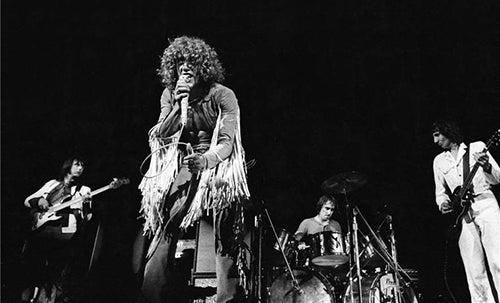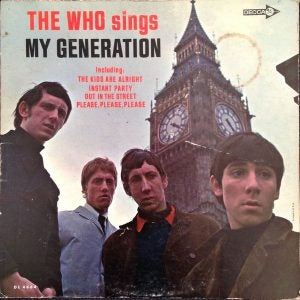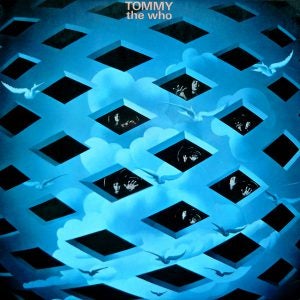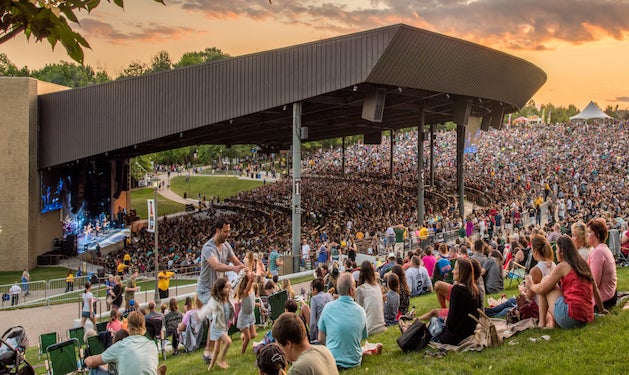Pete Townshend may not have enjoyed his experience at Woodstock, but the assembled crowd was treated to a spectacular performance as the sun rose, right on cue, and The Who played “See Me, Feel Me.” Bassist John Entwistle had it right: “God was our lighting man.”
Day Two, Performer 13: The Who
Performed Sunday morning, August 17, 5:30–6:35 am

John Entwistle, Roger Daltrey, Keith Moon, and Pete Townshend—The Who at Woodstock. Photo © Henry Diltz.
The Who Band Members
- Roger Daltrey: vocals
- Pete Townshend: guitars, vocals
- John Entwistle: bass
- Keith Moon: drums
The Who Woodstock Setlist
- Heaven and Hell
- I Can't Explain
- It's a Boy
- 1921
- Amazing Journey
- Sparks
- Eyesight to the Blind
- Christmas
- The Acid Queen
- Pinball Wizard
- Do Yo Think It's Alright?
- Fiddle About
- There's a Doctor
- Go to the Mirror
- Smash the Mirror
- I'm Free
- Tommy's Holiday Camp
- We're Not Gonna Take It/ See Me Feel Me
- Summertime Blues
- Shakin' All Over
- My Generation/Naked Eye
From the start, The Who was more than a rock band—they were a statement. They formed in London in 1964, rising out of the ashes of a group called The Detours, which featured John Entwistle on bass, Doug Sandom on drums, Roger Daltrey on vocals, and Pete Townshend on guitar. Initially influenced by British rock combos like The Shadows, The Detours eventually shifted stylistically toward American R&B and soul acts like James Brown. After discovering that another group was working under the name The Detours, the group renamed themselves The Who. Not long after, Doug Sandom was fired from the band following an audition for Fontana Records and was replaced by a young, Beach Boys-influenced drummer, Keith Moon.
Discovered playing London Mod clubs by an aspiring London manager named Pete Meaden, The Who were encouraged to change their name to The High Numbers (“Number” being a Mod leader, and “High” meaning, well, high), and it was under this name that they released their first single “Zoot Suit”/“I’m The Face” in July 1964. The lyrics to both songs were written by Pete Meaden, and crafted to appeal to The Mod crowd. The single went nowhere, and soon the band was back in the London Mod clubs, performing as The Who. In the fall of 1964, they caught the eye of genius aspiring managers/madmen Kit Lambert and Chris Stamp, who soon secured the band a deal with Brunswick Records, who issued the band’s first U.K. hit single “I Can’t Explain” in January 1965, written by Pete Townshend and produced by Shel Talmy (known for his work with The Kinks among others). More Talmy-produced hits followed in 1965 with “Anyway, Anyhow, Anywhere” and the defiant anthem, “My Generation.” December 1965 saw the release of the group’s first LP, also titled My Generation, (The Who Sings My Generation in the U.S.) which mixed R&B covers with Townshend originals.

(Decca, 1965).
In addition to their image as representatives of the Mod movement, The Who became known for their thrilling stage affectations, like Roger Daltrey’s swinging of the microphone like a lasso, Pete Townshend’s windmill guitar thrashing, and Townshend and Keith Moon’s destruction of their instruments at the end of each set. In many ways, the notoriety they received as a stage act often threatened to eclipse their success as a recording act, but it certainly did give the band greater press attention and an ever-growing fanbase.
In January 1966, The Who split acrimoniously from Shel Talmy and Brunswick Records, with Who manager Kit Lambert assuming record production duties. Issued on Lambert and Stamp’s own Reaction label, “Substitute” was another hit for the band. Their next single, “I’m A Boy,” became The Who’s first U.K. #1 hit, and they followed that up with their second album, A Quick One, which included their first Townshend-penned “mini-opera,” “A Quick One, While He’s Away.” December 1966 saw the release of an EP consisting mostly of covers titled Ready, Steady, Who as well as another single, “Happy Jack,” that became the first top 40 hit for the group in the United States.
1967 saw the group have more single success with “Pictures Of Lily” and “The Last Time,” the latter being a Rolling Stones cover issued as a support for Stones Mick Jagger and Keith Richards, who were facing incarceration after a trumped-up drug bust. In June, The Who made their U.S. debut at the Monterey International Pop Festival, going on immediately before Jimi Hendrix, who may be the only soul alive at the time who could have followed them that night. Their appearance at that festival and in the resulting D.A. Pennebaker documentary, Monterey Pop, gave them instant status as a major U.S. touring act. Later in 1967 came the release of the towering single “I Can See For Miles” and their magnificent third album, The Who Sell Out, a concept album that functioned as a tribute to England’s celebrated and recently outlawed pirate radio stations.
In 1968, in addition to writing more singles for The Who (“Dogs,” “Call Me Lightning,” “Magic Bus”), Pete Townshend began work on a full-blown “rock opera” that would tell the story of Tommy Walker, a fully-functional boy who is rendered deaf, dumb, and blind as the result of witnessing a traumatic and tragic event. Tommy’s parents try LSD therapy (“The Acid Queen”) as well as seeking conventional medical advice (“There’s A Doctor”) to free Tommy from his catatonic state. Tommy is also subjected to bullying (“Cousin Kevin”) and molestation at the hands of his Uncle Ernie (“Fiddle About”) and only begins to find his place in the world standing at a pinball machine, which he operates deftly despite evident inability to see or hear the game (“Pinball Wizard”). When his doctor notes that Tommy appears to “see” himself in a mirror (“Go To The Mirror”), his mother smashes the mirror in frustration (“Smash The Mirror”), returning Tommy to normal, though with a higher state of consciousness attained through his experiences (“I’m Free”). Attracting a cult of disciples, Tommy builds a “Holiday Camp” to show them the path to enlightenment, only to have his followers rebel against Tommy’s strict rules (no drugs, no drinking, etc.) and destroy the camp (“We’re Not Gonna Take It”).

was a staple of their live performances through 1969.
Released in May 1969 alongside the hit single “Pinball Wizard,” Tommy was an instant smash hit album. The Who were now superstars; night after night they played most of their new album to adoring crowds who elevated the group to the status of Rock Gods. As such, they were a no-brainer for the Woodstock lineup, though it took an all-night negotiation session with Woodstock production manager John Morris and Premiere Talent promoter Frank Barcelona to convince Pete Townshend to consent to have The Who appear at the festival.
By the time The Who took the stage at 5:30 a.m., the Woodstock crowd was nearing the point of exhaustion, most of their energies depleted by Sly & The Family Stone’s ferocious set. One person who seemed quite awake was New York Yippee/troublemaker Abbie Hoffman, who had come to Yasgur’s Farm with the goal of co-opting the festival for the promotion of his radical viewpoint. Abbie was quickly caught up in the medical emergency on hand at Woodstock and spent all of Friday and Saturday assisting on-site medical personnel. By Sunday morning, Abbie felt the need for a bit of relaxation and decided to pop a tab or two of LSD (history does not record exactly what color tab he chose to ingest). By mid-morning, he was tripping quite heavily and was apparently in need of getting his political rocks off. He took to the stage in the break between acts, loudly suggesting that the focus of the festival should be “freeing John Sinclair from prison.” Sinclair, a radical activist (and manager of the Detroit band The MC5), had recently been given a ten-year jail sentence for possession of two marijuana joints, and activists everywhere were incensed. Abbie was led off quickly, and was standing at the side of the stage when The Who began their set.
The members of The Who were not in a good mood. They had arrived on Saturday afternoon, and promptly spent the next twelve hours flat-out tripping against their will due to a contaminated backstage water and coffee supply. As they took to the stage, guitarist Pete Townshend took the opportunity to kick Michael Wadleigh, who was laying on the stage getting ready to begin filming the group, in the camera with his Doc Marten boots while Wadleigh was preoccupied with lining up a shot. This was a clear warning to the camera operators to get off the stage, and for the most part the band was able to proceed without further interference.
With the stage cleared, the band roared into their opening number “Heaven And Hell,” written by bassist John Entwistle. It was unreleased at the time but would crop up as a B-side the following year. This was followed by the band’s first single, the 1965 British hit “I Can’t Explain.” From here, the band went into their revolutionary and wildly popular rock opera, Tommy, which hit its stride fairly quickly with a devastating version of the instrumental “Sparks,” and continued apace through a rendition of the group’s current hit single, “Pinball Wizard.” Keith Moon was his usual wild man on the drums, John Entwistle played his bass almost like a lead guitar, Pete Townshend leaped, windmilled, played his guitar behind his head, and gave the audience a great show, and Roger Daltrey strutted, screamed, and performed every song with every bit of his energy. Their performance was a highlight of the 1970 Woodstock documentary and soundtrack album, and The Who further solidified their reputation as phenomenal live performers.
In the break following “Pinball Wizard,” the inevitable happened. Abbie Hoffman rushed out onto the stage, grabbed Pete Townshend’s microphone and screamed “I think this is A PILE OF SHIT while John Sinclair rots in prison!” Furious, Townshend cut him off with a bayonet-like thrust of his guitar’s headstock into the back of the Yippee’s head. Stunned, Hoffman jumped from the stage and, as legend would have it, ran all the way back to New York City. Contrary to the peace-and-love ethos of Woodstock, this bit of onstage violence was cheered by the crowd.
With Townshend’s Gibson SG now noticeably out-of-tune, the group thundered through a brief “Do You Think It’s Alright?” before Pete announced to the side-stage onlookers that he would kill the next person to walk across the stage. The sun reportedly began to rise during “I’m Free” and provided a stunning visual accompaniment to a brutal version of the Tommy finale “We’re Not Gonna Take It.” Muscular covers of Eddie Cochran’s “Summertime Blues” and Johnny Kidd And The Pirates’ “Shakin’ All Over” (both of which would be issued the following year on The Who’s Live At Leeds album) rounded out the main set.
Inevitably, the band was asked back for an encore, and surprisingly (given all that had gone down) complied. For this, they chose their 1965 anthem, “My Generation,” prior to which Pete sarcastically informed the crowd “we knew we were gonna come back and do it.” “My Generation” culminated in a brief pass through the riff of Townshend’s “Naked Eye,” which would eventually be released on the 1974 album Odds And Sods. Pete closed the show out by bashing his SG into the stage and tossing the broken instrument into the crowd. Chip Monck’s closing “ladies and gentlemen, The Who,” was rather eerie, intoned against a blast of bass guitar feedback.
In the years following Woodstock, The Who continued their rise to superstardom. They also continued to be innovators of new musical forms and Townshend’s usage of synthesizers. They released their classic Who’s Next album in 1971 and another rock opera, Quadrophenia, in 1973, followed by several other albums and side projects.
Keith Moon died of an accidental drug overdose in 1978 and was replaced by Kenny Jones on drums. By 1983, Townshend had had enough and left the band to pursue solo projects. The band has since reunited several times for various charity events and tours, until John Entwistle died of heart failure in 2002. Roger Daltrey and Pete Townshend still tour occasionally as The Who, and celebrated their 55th anniversary in 2019.
—Wade Lawrence & Scott Parker
